
In the River TAKAHARA --Vol.68--
Evening Rise
After the opening day in spring, the sunset becomes later, the river rises, the bait increases and fish become cautious. In any river fish appear less frequently during the fine daytime. That means evening fishing becomes more important.Fish become restless a little before evening rise. It is clear that fish have woken up from a nap and plan how to get dinner. The sunset will come soon, only an hour later. We anglers feel an hour, even if 3 hours, pass very quickly because we have been waiting for this special hour since the morning.


I memorized the fish I had missed, the interesting points and so on to prepare for the next chance.
There is the special moment in those 60 minutes when fish respond most vividly. It usually comes just before sunset. In that moment dry fly is suddenly seen dimly. It lasts only a moment. Both too early and too late starts of fishing often make anglers miss the precious chance. Therefore I think first of all how to stand at the most favourable point at the most favourable time and get there a little earlier to make it doubly sure.
Fishing Upstream with Dry Fly and Downstream with Wet Fly
However, I was not an angler just to wait for the supreme moment. I fished around the target point and caught nice fish in lucky casesThen I started fishing earlier at a little lower reaches of the target point and fished upstream so that I could get to my destination at the supreme moment. For example, if the supreme time is 6 o’clock in the evening I start fishing at 5 p.m. After calculating where to start in order to get to the target point in time, I start fishing upstream. However, anglers are often greedy and want to fish as large area as possible. Then I start at farther lower reaches of the target point. When I know I can not get to the target point in time I run on the bank or cast the fly in a slipshod way. We should not do these things. Finally I decided to fish upstream with dry fly and then downstream with wet fly, which enabled me to fish the same point twice.
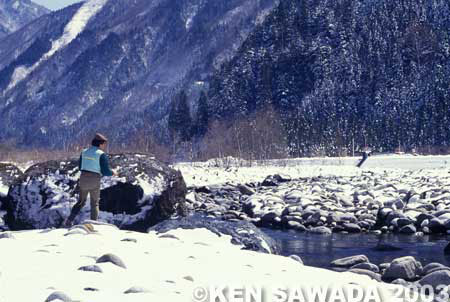
Almost all large pools keep fish in this season.
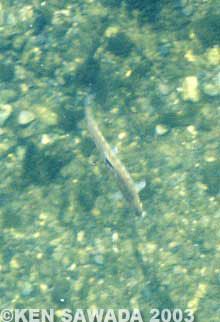
A staying yamame trout in the pool
I fished upstream to catch several fish with dry fly and returned to fish downstream to catch some fish that had not responded to the dry fly and some I had missed before. At first it was a satisfying way but when fish decreased and only cautious ones remained it was not so effective.
Some fish broke the surface but made U-turn just in front of the fly and never came back. Some seemed to bite the fly but I could not hook them and they ran away in surprise. In some cases just after I could hook the fish the hook came off the mouth and the fish ran away. As less and less fish bit the fly properly, anglers, including me, experienced those unlucky cases more often.
If I had stuck to that way of fishing I would have more often missed the fish that once responded to my dry fly, which means more fish would have run away, out of my reach. It was no good chasing the nervous fish too far with dry fly in this situation. That was my conclusion.
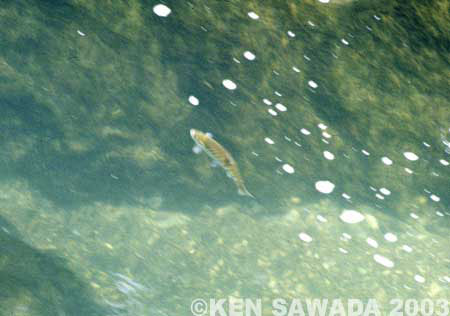
A yamame trout broke the surface, chasing small Olives.
Search
But I never thought that I would use wet fly from the first because it was no good, either, trying my luck of catch or miss when the fish did not respond well enough. My new tactic was to use dry fly to find the fish which might attack wet fly later.I started fishing at the lower reaches of the target point or the turn point and fished upstream with dry fly. It seemed the same way as before but now I fished upstream not to catch fish but to find them. I tried to find the fish which made false rises (not proper rises to bite the fly) and those which swayed to and fro or moved quickly under the drifting fly. When I found those fish I left there quietly. I never kept casting to catch them because failure meant a total loss.
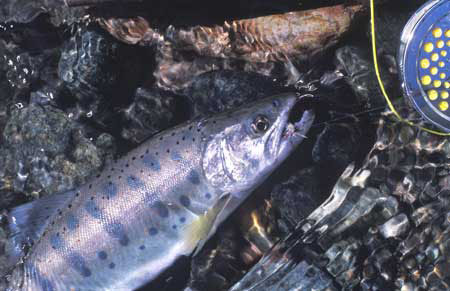
A yamame trout in high season that bit Spent Badger.
Instead, I watched the whereabouts of the fish very carefully. I imagined how I was going to fish that point on my way back: where to stand? to what direction and how many metres of line to cast? to what range to cast the fly when the fish move? what is the good mark in darkness? Actually I put a mark, if necessary, to avoid overlooking the point on my way back.
This method was very successful. I could fish upstream with dry fly at a brisk pace because all I had to do was to find fish. That meant I could fish wider area than before. On my way back I could concentrate on fishing where I had found the fish and where I wanted to cast the fly by all means in spite of no sign of fish before. That meant I could fish wider area in the limited time. To my surprise, on my way back I could really catch with wet fly the most of fish I had found on my way upstream.
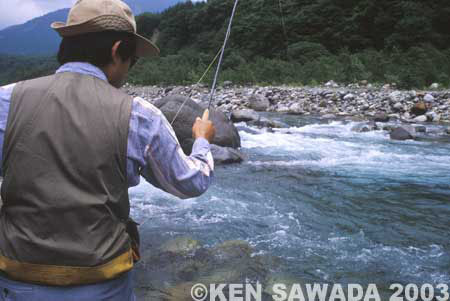
In the evening I tried to find big fish with dry fly.
The Turn Point
Sometimes I did not decide the specific point as the turn point but switched from fishing upstream to downstream, from dry fly to wet fly, at the good timing. Because I had had many experiences of this kind of switch in mountain streams and quiet rivers like Oshino or the Yukawa River, I had no difficulty in knowing timing. I changed from dry fly to wet fly as follows.- when dry fly is not clearly seen
- when plenty of sedges start flying
- when rises stop
- when fish suddenly respond to dry fly poorly even if there are rises
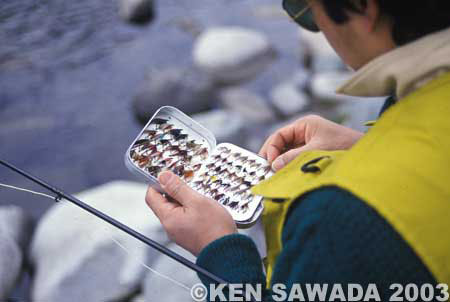
Fly size is completely different between streams in the beginning of the season.
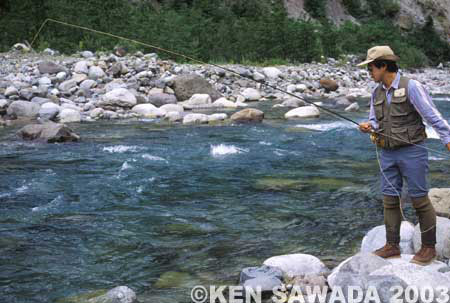
The upper reaches of Imadakan. Big yamame trout woke up from a nap before sunset.
Those were my rules of timing of fly change. But sometimes I intentionally altered my rule. I kept dry fly longer at clear low water when fish responded very well. I used dry fly as far as I could see it on the surface even dimly and sometimes after dark.
On the contrary, I changed it into wet fly earlier at high water or no-transparent water. Sometimes I used wet fly from the first at muddy water due to snow melting water or rain.
One thing was common to both cases. I had to change flies very quickly. I had seldom spent as much time as I liked. That was because I always stuck to the best fishing way to the last minute. To cut down the changing time I had prepared several kinds of wet flies put to the leader and kept them in the cast wallet. It was helpful to shorten the time. In addition, spare leaders were very useful when the leader was entangled by the fish I caught.
-- To be continued --
- NET SHOP INFORMATION
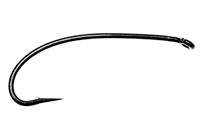
SL6 Black Spey Hooks
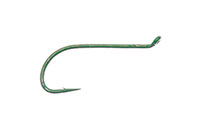
DU3 Limerick Spinner Hooks
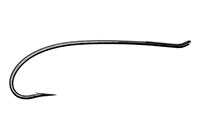
SL4 Single Bartleet Hooks
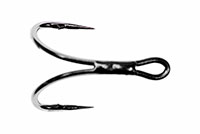
XD1 Tube Fly Double Hooks
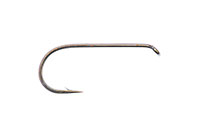
DD2 Flat Perfect Hooks
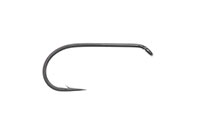
DD1 Black Terrestrial Hooks
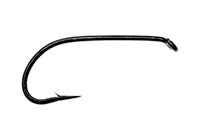
TD4 Old Limerick Wet Hooks
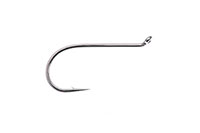
DU1 Silver May Hooks
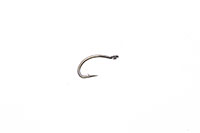
MU1 Flat Midge Hooks
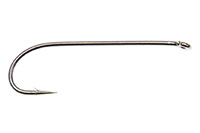
LD3 Long Limerick Hooks
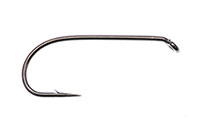
TD2 Summer Sproat Hooks
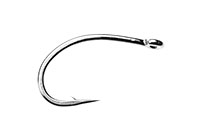
XS1 Tube Single Silver Hooks
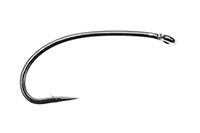
TD6 Siver Sedge Hooks

SL5 Black Spey Hooks

DU3 Limerick Spinner Hooks
- TROPHY CLUB
- FLY SHOW
- EXHIBITION
- MASTERS`
- FLY DRESSING CONTEST Archives
- TRAVELLER Archives
- TACKLE IMPRESSIONS Archives
- ANGLERS` PHOTO GALLERY Archives
- ----------------------------------------------
- トロフィークラブ
- フライショー
- エキシビション
- マスターズ
- フライドレッシング・コンテスト・アーカイヴ
- トラヴェラー・アーカイヴ
- タックル・インプレッション・アーカイヴ
- アングラーズ・フォトギャラリー・アーカイヴ
株式会社サワダ 185-0021 東京都国分寺市南町3-13-4
SAWADA'S INC. 3-13-4 Minamicho, Kokubunji, Tokyo 185-0021, Japan
写真・ドキュメントの無断転載を禁じます。
All the images and documents found on this site are owned by Ken Sawada and may not be used without permission.
But, link to this site is FREE.
Copyright © 2000 - 2025 SAWADA'S INC.. All rights reserved.
SAWADA'S INC. 3-13-4 Minamicho, Kokubunji, Tokyo 185-0021, Japan
写真・ドキュメントの無断転載を禁じます。
All the images and documents found on this site are owned by Ken Sawada and may not be used without permission.
But, link to this site is FREE.
Copyright © 2000 - 2025 SAWADA'S INC.. All rights reserved.
